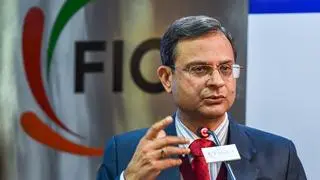After a gap of several years, public sector has been put to a significant leadership role in the country's infrastructure development strategy.
This is important as the Centre had in recent years been largely betting on public private partnerships (PPP) to deliver the results on the infrastructure front.
It is not that PPPs are now being given up, but the balance has got heavily tilted in favour of the Governmental push to infrastructure development, say infrastructure experts.
With several private sector balance sheets largely stretched, the Centre has now made the right move in taking the lead role and relying on the public sector to don the mantle, they said.
Heralding this change in approach was the latest budget 2015-16 which clearly showed that the Government and the public sector would now be the key driver of infrastructure development—both from funding as well as the aspect of readiness to take risk.
The package of measures announced includes additional Rs 70,000 crore investments in infrastructure in 2015-16, over the year 2014-15 from “the Centre’s funds and resources of CPSEs”.
“This is a policy statement of the Finance Minister. The actual modalities have to be worked out”, a Government official said, admitting that no clarity existed on the respective share of the Centre and CPSEs to the Rs 70,000 crore investment amount.
This additional investment of Rs 70,000 crore will form part of the $ 1 trillion estimated requirement for infrastructure over the next five years.
The Government is expected to bring in $ 500 billion with rest coming from banks and private sector.
“It is very clear that public sector is back as the key driver for infrastructure development. Funding of Rs 70,000 crore may not be an issue, but the rider is no details are yet available”, Vishwas Udgirkar, Senior Director-Infrastructure, Deloitte in India told BusinessLine
Some experts reckon that Jaitley’s decision to settle for a higher than expected fiscal deficit of 3.9 percent of GDP in 2015-16 will help garner resources for Governmental infrastructure push. Welcoming the budget announcements, Manish Aggarwal, Partner, Corporate Finance, Infrastructure and Head-Energy & Natural Resources, KPMG in India, said there were several positive measures.
In the medium-to-long term, several key building blocks like revitalising PPPs, creation of bankruptcy code, formulation of contract dispute (resolution) Bill and Regulatory reform law have been spelt out.
However, in the short-to-medium term, resolution of the huge “stressed assets” that existed in the infrastructure sector is yet to be addressed, he said. This is crucial as it impacts the banking system’s ability to finance new capacity creation and developer’s ability to bring in more equity funds for additional capacity, Aggarwal added.
Jaitley’ s announcement to set up a national investment and infrastructure fund (NIIF)—with annual flow of Rs 20,000 crore from the Centre—was widely welcomed, as it could have multiplier effect.
However, Jaitley has said that monies have to be found for this purpose.
With the Government itself putting its skin in the game, it may not be difficult to tap foreign investors to raise debt money for the Trust.
The Trust is then expected to invest as equity in infrastructure finance companies such as IRFC (Railway Projects) and National Housing Bank (Housing for All).








Comments
Comments have to be in English, and in full sentences. They cannot be abusive or personal. Please abide by our community guidelines for posting your comments.
We have migrated to a new commenting platform. If you are already a registered user of TheHindu Businessline and logged in, you may continue to engage with our articles. If you do not have an account please register and login to post comments. Users can access their older comments by logging into their accounts on Vuukle.